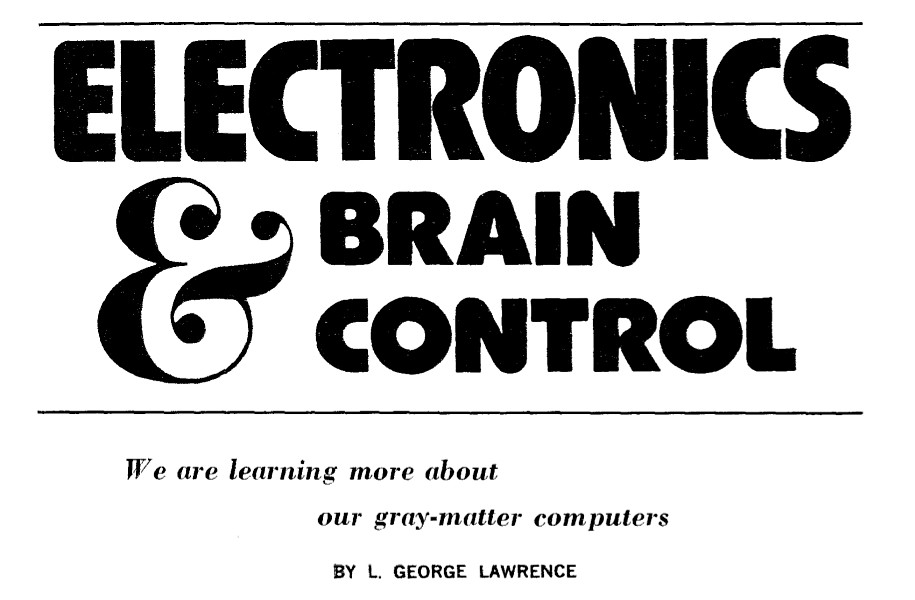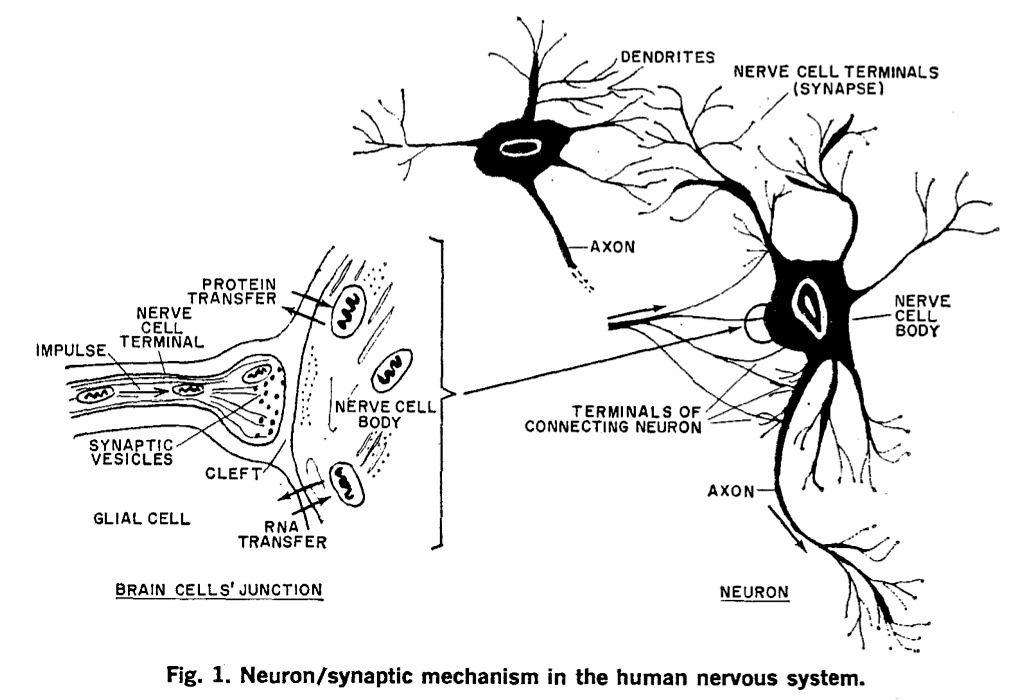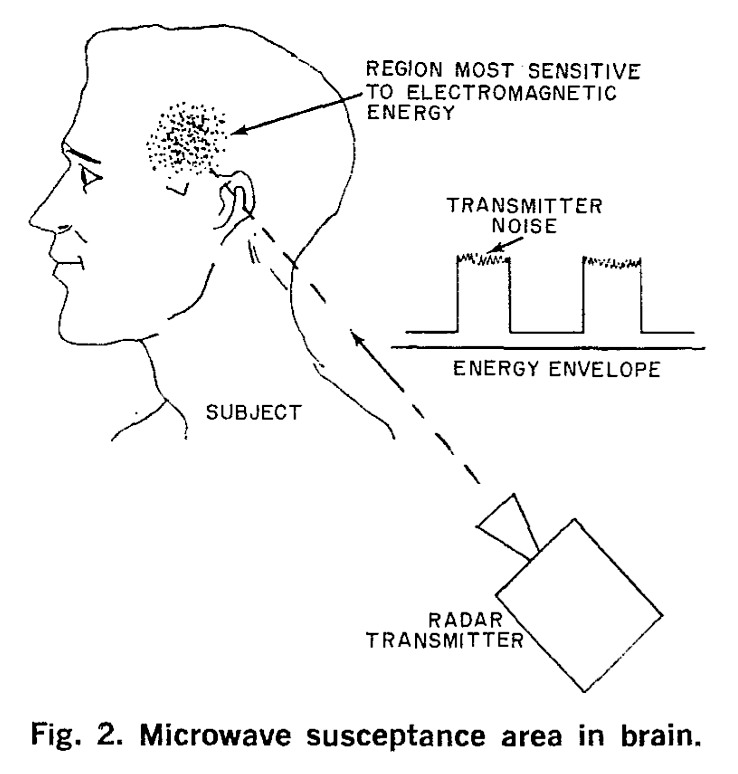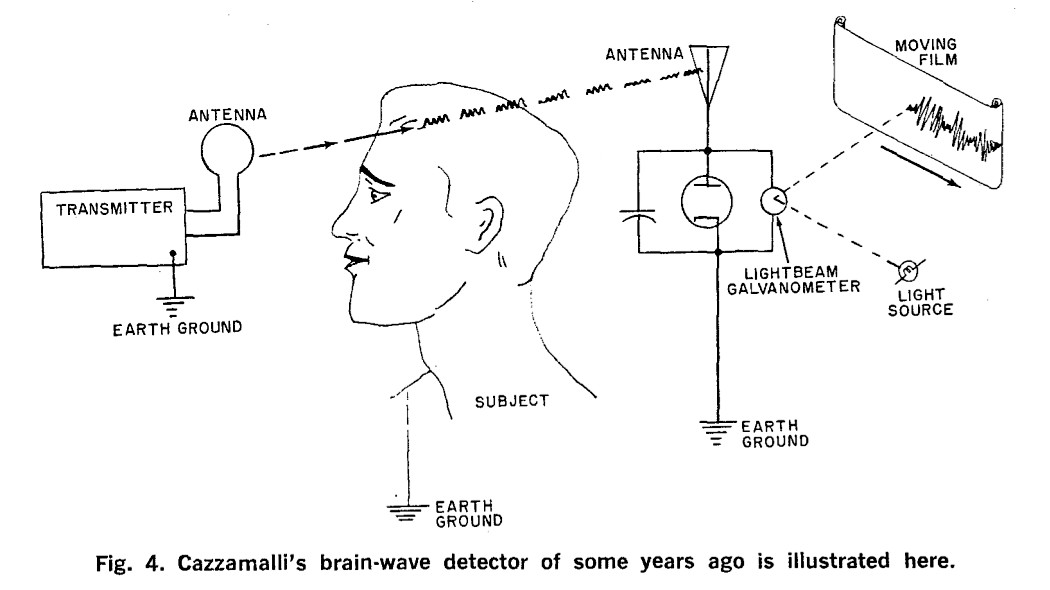
IT IS TIME that we closely examined brain control, now that scientists are actively seeking to unravel the mysteries that shroud that miniature bioelectric giant known as the human brain. Elements of brain control can already be found in anti-collision radar technology involving birds. It has also been substantiated that, by pumping energy in the gigahertz range of frequencies through human heads, subjects can suddenly "hear" without using their ears.
Much remains to be done to correlate and sift out concealed facts. We still know very little about the all-important coding events that take place in the brain's neuron-synaptic complex. How can we measure and reinforce such significant human capacities as love, will, and character? Does uncontrolled electromagnetic pollution affect the brain? These and other questions remain to be answered as scientists delve deeper and deeper into the human brain with the help of electronics.
What Is the Brain? The theory that the brain is a true electronic machine has often been proposed. To a point, the theory is true. As Dr. Wilder Penfield demonstrated some years ago, the electrical stimulation of brain tissue during skull surgery triggers lucid audio-visual recalls of past events in patients. The patient "sees" and "hears" complete increments of true life experiences, all in correct sequence.
But consider Fig. 1. Studies are enormously complicated by the fact that the human brain contains an estimated 10 billion nerve cells called "neurons" and another 100 billion of a second type called "glial" cells. The fluid bath in which these cells are suspended is a vital element in their electrochemical interactions. Is it here where emotional components and memory are stored and where we have susceptance to microwave and other electromagnetic frequencies?

Such questions guide us into the subject of "synaptic" transmission. The term "synapse" is derived from the Greek phrase "to clasp" and was introduced in 1897 by a Dr. Sherrington who used it to describe the junctional region between two nerve cells. In many cases there is a gap or cleft across a synapse. (In other cases, as in fish, a synapse is a real physical joint.)
One big neuron might have on its surface as many as 10,000 points of contact (synaptic knobs) with other neurons. When the latter are stimulated, some of the millions of ribonucleicacid (RNA) molecules inside them give orders to the glial cells to manufacture new proteins. The nature and pattern of these proteins contain an imprint of something that has been perceived and apparently gives rise to a molecular "engram."
We also find electrical dipoles in synaptic mechanisms which, when oriented and arranged in a large array, apparently can produce an electric field strong enough to drive positive ions over the junction barrier of the post-synaptic membrane (in a manner similar to that in a transistor) and thereby initiate excitation or produce depolarization. So, one comes to believe that the nature of synaptic transmission is essentially electrical, be it mediated by electrical or chemical transmitters.
By inference, then, the possibility arises of human brain control by electromagnetic forces directed at it from the outside. If such radiations can be suitably coded to elicit a synchronous response in the neuron-synaptic complex, the brain will trigger motor functions which, in turn, cause man or animal to execute a programmed act. Here we have some fascinating experiments that hold great hopes for the immediate future.

In the case of hearing, for example, we have been taught that our auditory system can respond only to acoustic energy. This "fact" is far from correct. Experiments conducted by Dr. Frey and others clearly indicate that the audio sense in man — and probably in animals, too — can respond to electromagnetic energy in at least a portion of the r-f spectrum. Data shows that at very low power levels (to preclude biological damage) in tests like that shown in Fig. 2, there are audio sensations at frequencies as low as 200 MHz and at least as high as 3 GHz. When low-level energy was directed at them, the test subjects reported "hearing" a buzzing sound. However, they found it almost impossible to match r-f sounds to a sine wave. The apparent source of the buzzing, clicking, knocking, or hissing sounds is described as being within or immediately behind their heads. This localization persists no matter how a person rotates or twists his head in the r-f field.
It was during these studies that a profoundly important discovery was made: deaf subjects often had the ability to hear r-f sound. The clinical criterion was that, if a given person could hear audio above 5 kHz either by bone or air conduction, then r-f sound could be heard as well. This and related work has resulted in the manufacture of r-f type hearing aids for the deaf, one of which is made by Listening, Inc., 6 Garden St., Arlington, Mass., and is known as the Neurophone Model GPF-1. It operates at 100 kHz and employs crystal control.
These observations tie in with the fact that some individuals can detect radio programs through the fillings in their teeth. This phenomenon was technically verified by interposing shields between respective people who exhibited it and the modulated r-f sources. When the lower half of the head was covered, including the maxillary dental area, the r-f sound was perceived. The sound ceased upon covering the top half of the head. While the mechanism responsible for this phenomenon is only imperfectly understood, it can be assumed to be the result of direct cortical nerve fiber stimulation.
We also have another form of hearing sensations that come about when the human head is placed between two large capacitor plates that are excited by varying electro-static potentials. "Electrophonic hearing," as it is called, apparently acts on the ear's tympanic membranes in a quasi-mechanical manner. It is useful as a new research tool in specialized psycho-physiological studies on the auditory or vibrotactile system.
Unavoidably, data of this sort begs application. Pilot studies are under way to apply effective electrodynamic brain control to animals and man himself. Consider, for example, the brain-wave proposal based on ideas put forth by the late Dr. Norbert Weiner, the acknowledged father of cybernetics.
According to Weiner, a sheet of tin suspended from the ceiling of a room and connected to a 10-Hz electrostatic generator can cause unpleasant sensations in human subjects. With a field strength of 1 or 2 volts per sq em, the oscillating field roughly coincides with the human brain's alpha-rhythm frequency but attempts to lock it to a fixed frequency — that of the generator. Electronic sleep machines employ similar principles, with currents of fixed amplitude and pulse width (usually square waves) being fed by conductive face masks through the cranium and brain.
Brain Control of Birds. Radar technology is now being used to deal with the problem of birds getting in the way of fast flying aircraft. The idea is to trigger a flying bird's (or a whole flock's) brain into motor functions to initiate collision avoidance by having the bird(s) veer off the flight path of the plane. This area of research was triggered by the staggering incidence of plane/bird collisions that result in equipment damage estimated to be in the millions of dollars each year and the human lives that continue to be lost as a result of such collisions.

The work being carried out by the National Research Council of Canada bears much promise in bird-brain control. The NRC's test system takes the form of a carousel of bird cages containing live chickens. (Fig. 3) Only one of the many cones suspended above the cages contains a microwave antenna. The program, headed by Dr. Alan Tanner, aims to evolve microwave brain-control systems that will have the greatest possible effect on birds while at the same time deploying the least amount of power.
When exposed to microwave radiation, birds in general exhibit escape reactions. This fact became clear during World War II. Investigators also found that in each case the microwave field through which birds were flying was of very low intensity — too low, in fact, to account for confusion and escape reactions on the basis of heat generated in the animals' bodies.
Different species of birds have different behavioral patterns. In the laboratory, a few seconds after the microwave field has been initiated, the given bird's wing outside the field of radiation became collapsed and the opposite wing became extended. Similar phenomena were observed with the legs. Sometimes the birds heeled over to the outside of the field. In the turning reaction, the outer side of the bird becomes, paralyzed. In short, the microwave beam interacts with the nervous system of the test birds. Seagulls and pigeons reacted similarly, though the gulls are more inclined to initiate flight.
It is interesting to note that a bird's feathers appear to play a much greater role in the sensory complex than has been realized before. Defeathered chickens, for example, give little or no reactions to microwave fields until the twelfth day, at which time new feathers start to grow and tips protrude from the surface of the skin. In the case of fully feathered chickens whose tail feathers were exposed to microwave radiation, the birds immediately ceased exploration of their cages and exhibited mounting signs of distress after a period of 10-20 seconds. When the microwave field was switched off, the birds responded by fluffing their body feathers and active preening.
The Canadians believe that the physical properties of quill tissue — particularly the piezoelectric properties that are fundamental to living tissue — suggest mechanisms that have heretofore been overlooked. However, work carried on by Dr. Tanner and his staff as well as research conducted elsewhere should in time yield a microwave beam of the proper wavelength and modulation to cause birds to activate collision avoidance with all possible haste.
Brain·Wave Detection. Some 40-odd years ago, university professor F. Cazzamalli started publishing papers on the subject of brain-wave detection and implied that he had detected radiations from the mind. As shown in Fig. 4, he placed subjects in a shielded room (or Faraday cage), emanated vhf radio waves through their heads, and claimed to have recorded "beat frequencies" obtained with an untuned receiver consisting of a galena crystal or diode tube, a fixed capacitor, an antenna, and a sensitive light-beam galvanometer.

The trouble is that Cazzamalli never mentioned transmitter power in his somewhat unprofessional papers. His oscillograms meant to show variations of the "beat" when his subjects were emotionally aroused or engaged in creative tasks when they were in the Faraday cage. Later, he told an astounded world that his subjects would hallucinate when under the influence of his "oscillatori telegrafica," its frequency being about 300 MHz at the time.
Tom Jaski, a noted science writer and engineer, duplicated some of Cazzamalli's work with a modern low-power oscillator that was swept from 300 MHz to 600 MHz. His subjects could not see the dial. They were told to sound off as soon as they felt something unusual. At a certain frequency range — varying between 380 MHz and 500 MHz — the subjects repeatedly indicated points with exact accuracy in as many as 14 out of 15 trials. At these "individual" frequencies, the same subjects announced having experienced pulsing sensations in the brain, ringing in the ears, and an odd desire to bite the experimenters. The oscillator's output power was only a few milliwatts, while the oscillator itself was located several feet away from the subjects.
The Conclusions. Considering the ingredients of the few sample discussions presented above, it appears that both humans and animals have brains sensitive to r-f energy. The correlating mechanisms are only imperfectly known, but they apparently reside within the neuron-synaptic complex. Nor will we know how this susceptance affects our longevity without proceeding with a great deal more research.
Just how electromagnetic radiation affects our social structure has led to a great deal of speculation in the past. For example, the late Dr. Goldman once insisted that r-f energy allows the id, or primitive brain, to take control over human affairs. Such considerations might open a Pandora's box when applied to an explanation of our sharply increasing crime rates and decline of social fidelity. So, before we rush pell-mell into electromagnetically contaminating our environment, it would serve us well once and for all to discover what adverse effects, if any, it will have on our lives.
Originally published in "Popular Electronics" (July 1973). Browse AmericanRadioHistory.com for complete issues of P.E. and many other historical radio and electrical publications in PDF format.
Return to the BIO-ICOMM Project homepage or the Bibliography of L. George Lawrence.
